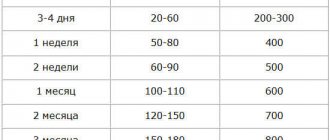There are many questions and problems associated with feeding a newborn. The advantages of breastfeeding are obvious: in addition to the fact that it is simply necessary for the health of the newborn, it is also useful, convenient, and does not require costs. But the situation is not always in favor of breastfeeding. Very often, the baby has to be fed or supplemented with formula, after which he develops an addiction to the bottle. Breast refusal begins to worry the mother. How to wean a baby to the breast after a bottle - this is what our article is about today.
Common reasons for babies refusing to breastfeed
Refusal to breastfeed can be due to various reasons: errors in breastfeeding, weak sucking reflex, illness of the baby, separation of mother and baby, getting used to the bottle, etc.
Breastfeeding experts have traced a pattern between breast refusal and nipple addiction. It turned out that 90-95% of all babies’ refusals from their mother’s breast are associated precisely with sucking nipples and pacifiers. And it’s not surprising, since the process of sucking a woman’s breast and the process of sucking a pacifier are radically different:
- A woman's breasts are soft and pliable; the baby easily sucks the nipple deep into the mouth. If the child takes the breast correctly and works with the lower jaw, then a vacuum is created inside the oral cavity, and milk flows out of the breast under the influence of pressure. The pacifier is not plastic; the baby’s mouth must “adapt” to it.
- When latching onto the breast, the baby needs to open his mouth wide, and when sucking the nipple, it is enough to open it slightly and stretch out his lips with a tube.
- When sucking the breast, the muscles that move the lower jaw work, and when sucking the pacifier, the muscles of the cheeks work.
- Tongue movements also differ between different types of nutrition. Thus, infants make wave-like movements with their tongue, and artificial babies make pushing movements.
After a long period of feeding from the pacifier, the baby's natural sucking process is modified, adapting to the pacifier. The oral apparatus gets used to working differently. Unlike a bottle, from which milk flows into the mouth on its own, sucking at the breast requires effort. As a result, getting milk from the breast begins to cause dissatisfaction in the baby, and the child refuses to take the nipple.
Bottle feeding is not always a mom's whim. There are times when artificial feeding is necessary (for example, in the case of separation of mother and child after childbirth). It is possible to re-wean a baby to the breast. Moreover, the vast majority of women interested in breastfeeding succeed.
How to teach a baby to breastfeed
Don't panic and remember that any baby will sooner or later develop a sucking reflex. After all, it is laid down by nature itself. If you understand the roots of the problem, it will be much easier to solve it. In any case, it is possible to revive your child’s love for breastfeeding by using the following techniques:
1. If possible, do not offer a bottle or pacifier to your newborn.
Of course, it’s hard to think of a more convenient means of supplementing with formula or expressed milk than a bottle. But the price of convenience may be the child’s refusal to breastfeed, so it is much wiser to use a spoon or syringe without a needle. If you are already using a pacifier, then to successfully normalize breastfeeding it is better to do without it. Gradually accustom your baby to other methods of calming. For example, you can rock him in your arms or on a fitball (large ball). And when he calms down, offer the breast. (see article on how to wean a child off a pacifier)
2. Be gentle but persistent
Offer the breast to your newborn for any reason - when he cries, expresses dissatisfaction, or behaves restlessly. Do this at any time during the day and at night when he tosses and turns in his sleep (see article on the benefits of night feedings). But under no circumstances be irritated and do not force your baby to take the breast by force! After all, only the brightest and most joyful things should come from mom. During this period, your best “helpers” should be gentleness and patience.
3. Devote all your free time to your baby
24/7 communication with mom is one of the most effective ways to teach a baby to breastfeed. It is important that he gets used to sleeping together, close contact with the person closest to him, and remembers his mother’s voice and smell. All this will awaken trust in him and make it clear that from the mother’s breast, like from the mother herself, comes calm and safety. During the period of weaning, it is advisable to limit the baby’s contact with other family members and strangers.
General recommendations for weaning your baby to the breast
How to wean a baby to the breast after a bottle? General recommendations for mothers:
- Allow the baby to get hungry and only then offer the breast. Do not rush to give him a bottle at the first request. The baby may be a little angry, but after that he will take the breast.
- Soothe your baby with your breasts. When the baby is capricious and nervous, let him hold the breast in his mouth. Of course, there is no need to force him! Remember that during hunger it is difficult for a baby to draw out milk. It is easiest for him to breastfeed in a calm state, when he is happy and not nervous.
- Stay with your child as much as possible. Hug him more often, let him remember his mother’s smell, the sound of her voice.
- Find a position that is comfortable for feeding. It should be comfortable not only for the mother, but also for the child himself.
- Use silicone breast pads. If other methods fail, purchase breast pads. They will remind your baby of a nipple from a bottle and he may want to suck on it.
- Don't give your child a pacifier! It is precisely because of the differences in the technique of sucking the pacifier (pacifier) and breast that the baby refuses breast milk!
- Try giving up the bottle altogether. Move it very far away or throw it away completely. It is better to feed your baby from a spoon or syringe without a needle until he refuses breastfeeding.
Listen to advice from the personal experience of one of the mothers:
How to properly offer your baby the breast
To establish breastfeeding, the child needs to be breastfed correctly. This must be taken care of from the first days of the baby’s life. How to teach your baby to latch correctly?
- Before applying, you need to press the baby as close to you as possible. Hold your neck with your hand so that the head moves freely.
- Before you start feeding, you need to make sure that the baby has his mouth wide open. If the baby's mouth is not fully open, he will latch onto the nipple incorrectly or bite it with his gums. The nipple should be directed towards the nose; you can put it in your open mouth yourself.
- A mother does not always understand her child. If the baby turns his head and does not take the nipple, this does not mean that he does not want to eat. Most likely, the little one is hungry and is looking for mammary glands with such movements.
- It happens that the baby begins to suck milk and may bite. Of course, this will cause pain. In this case, you need to press your finger on the baby’s mouth so that he releases the nipple, and offer it again. If the mother experiences pain during feeding, the baby may have latched onto the nipple incorrectly.
- If the mammary glands are very engorged and tight, before feeding you should stretch them and express a little to make it easier for your baby to latch onto the breast.
- When the baby takes the nipple correctly, it will touch the baby's palate. The chin should rest against the mammary gland, and the lower lip should bend. Almost the entire areola will be in the mouth; only its small upper part may be visible. During sucking, throat sounds should be heard and there should be no pain.
As mentioned above, it is recommended to feed the baby with mother’s milk no less than when he is one year old.
Important rules for transitioning to breastfeeding
What to do when children prefer to eat from a bottle? The surest way to resume breastfeeding is to completely give up bottles, nipples and pacifiers. Of course, this task is not simple and requires more than one day of time. But you will definitely be able to wean your baby to the breast again if you really want to. When switching from artificial feeding to breastfeeding, it is important to adhere to some rules:
- You cannot immediately deprive your child of supplementary feeding. The baby will be on mixed feeding for some time. But there is a reason to reduce the amount of supplementary feeding by 60%, that is, more than half. Supplementary feeding should be given in equal parts 5-6 times a day. When feeding your baby, leave a little supplement in the bottle, and give the rest of the formula to your baby from a spoon or syringe without a needle. This is exactly what happens when you give up the bottle. The baby gradually forgets the technique of sucking the pacifier.
- Those wishing to resume breastfeeding should throw away the pacifier. Breast refusal due to a pacifier is very common. If the baby is very accustomed to the pacifier, then you can wean him off it over the course of several days, gradually.
- As mentioned above, there are significant differences in breast sucking technique and pacifier sucking technique. To achieve correct attachment, use your clean index finger. Periodically give it to your baby for sucking, but only with the pad up, towards the sky. With such sucking movements, the child trains the muscles of the tongue and prepares his oral apparatus for the correct grasp of the breast.
- Give the breast at night. Why is it important? Firstly, it is easier to “deceive” a child in a sleepy state. And secondly, night sucking stimulates the production of breast milk and thereby improves lactation. Try putting your baby to bed next to you at night. Co-sleeping has helped many mothers overcome breast refusal.
- Until feeding is fully established, transfer the baby from one breast to the other 3-4 times during one feeding. To improve lactation, express a little (!) milk after feeding, especially if the interval between feedings is long.
Teaching a newborn baby to take the breast correctly for breastfeeding
There are different situations when you need to know how to wean a baby to the breast. In 90% of cases, the process is carried out from the moment of birth. General principles and recommendations will help you avoid mistakes. Care must be taken, since in case of negative actions the baby may completely refuse to suck.
The process of feeding is an unforgettable stage in a woman’s life.
Natural nutrition for a newborn is mother's milk. It contains all the components that allow it to grow healthy and actively gain weight. Establishing breastfeeding is an important stage, which must begin in the maternity hospital. You should not expect success on the first day. This takes from 1 week to 2-3 months - each case is individual.
Early application
It is recommended to use the early breastfeeding technique. Ideally, the first time this should happen 30-40 minutes after birth. In time - for 10-15 minutes.
This action will stimulate the mammary glands to produce milk. Lactation will gradually begin to increase, as the body will produce the hormone prolactin.
Also, early latching will quickly teach the baby to latch on to the breast (reflexes will start).
How to teach a child
How to potty train a child
Weaning a baby to the breast should begin immediately after birth (if there are no contraindications).
On the first day, he will not yet be able to fully suck or grasp the breast, but he will be able to get an idea of maternal warmth. Reflexes will start immediately. For a woman, the accustoming stage is associated with setting up the process of milk production.
Proper lactation (without interruptions and with a sufficient volume of nutrient fluid) will take time.
Important! In most newborns, the sucking reflex is well developed. During the first feeding, you need to pass the nipple across the lips 2-3 times so that the baby opens his mouth and captures the areola.
You should not force the baby or try to help him. The reflexive grip must be developed independently so that the baby can then receive the volume of milk he needs.
The woman will only need to apply light pressure on the mammary gland to activate production. In the first few days you will have to feed using colostrum.
You cannot supplement with the mixture if the natural way of eating is a priority.
Proper training assumes that the baby will need to be attached to the breast, taking into account all the features:
- body position is comfortable;
- the head should be at the same level with the body (not sunken);
- shoulders should not arch or sink;
- mouth at the level of the areola;
- lips should not close.
The position of a nursing mother can be any. It is allowed to sit, lie or stand. You need to hold the baby with one hand, with the other to guide the breast and support the nipple so that it does not fall out.
Important! In some cases, the baby may turn its head in search of the breast. It should not be fixed; it is recommended to carefully guide the head. This way he will understand what needs to be done next time.
If feeding is done correctly, then during sucking the woman will feel a slight tugging in the chest. This is due to the fact that the baby makes an effort to get milk. It is often noted that the newborn refuses the breast, cries, or behaves restlessly.
This is a normal effect if, before the training, another method of feeding was practiced: through a tube or using a bottle. Failure is also typical for premature babies or after interruption of breastfeeding for a number of reasons.
A cesarean section can also delay training, since local or general anesthesia is used during the process.
For quick contact you will need to interest the baby
How to offer correctly
Offering and teaching a newborn to breastfeed follows certain rules. It is recommended to carefully study the rules for grasping the nipple and areola in the baby’s mouth, so that you can then monitor and help him.
A variety of methods and techniques of “persuasion” are used that contribute to the development of reflex memory. In order for the baby to learn quickly, you will need to be persistent.
It must be presented in a soft form, otherwise the child will receive negative emotions.
Nipple latching rules
How to teach your baby to sleep in his own crib
In 90% of cases, the baby latches onto the nipple correctly. In order to control the process, the woman is recommended to take a comfortable position. The best position is sitting or lying down, this way you can relieve some of the stress from the muscles of the back, abdomen and arms. After this, the baby is applied to the breast. It goes according to the following rules:
- bringing the child's face closer to the mammary gland;
- The baby’s shoulders and head need to be supported with one hand;
- direct the nipple to the baby's lips, then pass along them 2-3 times, bring it to the nose.
At this stage, the newborn grasps the nipple and begins active sucking.
General techniques of “persuasion”
In the literal sense, it will not be possible to persuade the baby. By “convictions” you need to understand gentle actions, help, and kind words. Hugs are important here; they help the baby feel the warmth of the mother's body.
Much of success depends on the belief that breastfeeding will be the main way of nutrition. Calmness and restraint will show the child that there is nothing scary in the sucking process. “Beliefs” also include strictly defined hours for taking small meals.
It is recommended to use this technique in order to develop in him a reflexive concept of the connections between hunger and the method of satisfying it. In order to arouse interest, you should make sure that you fall asleep at your chest.
Additional feeding tips:
- turn on quiet soothing music;
- make the light dim;
- accustom gradually (do not expect results on the first day);
- sing songs or tell stories.
There is no need to rush, as the child should feel harmony and peace at this moment.
Important! If special persuasion techniques are used, a feeding bottle is not used.
Gentle Perseverance
When thinking about how to get a baby to suckle, you need to remember that the foundations of success are gentleness, patience and love. If the baby does not latch onto the breast or refuses, cannot hold the nipple or does not fully latch on to it, the mother should gently guide the baby’s actions. Also, the mammary gland should be in a position that is comfortable for the baby.
Bottles do not contribute to breastfeeding
Why do children refuse breastfeeding?
How to wean a baby from breastfeeding before one year
There are reasons for a child to refuse breastfeeding. Experts highlight the following:
- active use of pacifiers and pacifiers;
- bottle feeding (immediately after birth or at the time of interruption of breastfeeding);
- improper attachment to the breast (the baby experiences discomfort during this period, which makes him refuse next time);
- disease of the newborn (congenital, acquired disorders or the common cold);
- colic and abdominal pain;
- the beginning and active phase of teething;
- changes around (increased attention, cold, heat, bright light).
The use of creams or perfumes with a strong odor can negatively affect the desire to breastfeed.
You also need to monitor the foods that are included in the diet - some of them cause changes in the taste of milk.
Refusal from this method of feeding may be due to the fact that the child is already quite old. In some cases, on the contrary, it is easier to accustom someone to breastfeeding than to wean them off it.
Errors during training
Sometimes, when thinking about how to quickly accustom a child to breastfeeding, a mother does not take into account the possibility of mistakes. There are a number of actions that cannot be performed in order for training to be successful. Also, special attention should be paid to developing the application technique. Choosing a position that is comfortable for you and your baby is very important.
Incorrect application
Pressing too tightly, lack of support for the shoulders or head - all this refers to incorrect attachment. At this stage, you need to provide the child with freedom to choose a position (with control). In the found position, further feeding is carried out.
What not to do
There are several prohibited actions during training for breastfeeding:
- use a pacifier;
- give a bottle;
- to be nervous;
- show impatience and anger.
On a note. The child senses the mother’s mood, so he may start crying in response. You should also not rush or make sudden movements.
How to resume breastfeeding
You need to know not only how to introduce a newborn to breastfeeding, but also how to return breastfeeding in case of interruption. Sometimes it needs to be moved due to illness. The main recommendation is to devote enough time to this process.
It is important to establish close contact with the baby (snuggle, caress). It is best not to ask other relatives to look after him.
You also need to reduce the time you spend in crowded places, as this will allow you to resume contact with the mammary glands at any time.
It is important for a young mother to learn the technique of how to properly teach a baby to breastfeed. The first thing you need to consider is that the bottle should not be used even as a means of supplementary feeding. Proper sucking is genetically determined (clan, family). That is why problems do not arise in most cases.
Source: //kpoxa.info/sovety-mamam/kak-priuchit-rebenka-k-grudi.html
How do you know if your child has enough nutrition?
Refusing supplementary feeding, many mothers worry about whether the baby receives enough nutrition. 3 days after reducing supplementary feeding, you can do a “wet diaper test”. The purpose of the test: to count how many urinations a child will have per day.
In a healthy state and with normal nutrition, the baby should urinate at least 12 times a day. If the test is positive (there were more than 12 diapers), then the amount of supplementary feeding can be reduced by 10-20 grams. If the number of wet diapers is less than 12, this may mean that the baby is not getting enough nutrition. In this case, it is better to contact a breastfeeding specialist to determine the next steps for weaning your baby.
Weight dynamics will also make it possible to find out whether the mother is on the right track. In 1 week, the weight gain should be about 120 grams.
A breastfeeding mother needs to be prepared for the fact that the period of breastfeeding will be difficult, and the baby will probably break out of the routine. The child may be accompanied by restless sleep and anxiety during wakefulness. At first, the baby refuses breast milk. But with the right actions, on the 3-4th day the baby still “hangs” on the chest.
How to get a baby to latch on?
Feeding a newborn is not difficult, you just need to put the baby to the breast correctly. Difficulties arise if the baby was fed formula from a bottle, sucking was interrupted for a long time, etc. In such cases, you should not force the baby to take the breast. It is better to accustom him to this process gradually.
The baby will be more willing to latch on to the breast if you lubricate the areola with milk before each feeding. Once he smells it, he may try to get the milk himself. Don't rush into bottle feeding. Before giving your baby a pacifier, offer him a taste of warm mother's milk. If the child has recently eaten, then you should be persistent and not give him a bottle.
But what if the child still refuses to eat? It often takes time for a baby to get used to the mother's breast. The decisive factor in giving up the bottle may be contact with the mother's body. To speed up this process, it is necessary to offer the baby the breast more often, not only for sucking. During sleep, you can place the baby next to you, and during periods of wakefulness, let him play with the breast.
A few words about supplementary formula feeding
Before you start feeding your baby, you need to make sure that it is really necessary. Additional feeding unnecessarily will inevitably lead to the extinction of lactation. It all happens like this: the baby is full of complementary foods and will not need breast milk for a long time. At this time, the woman’s body receives a signal that breast milk is not in demand. As a result, milk production decreases.
If it seems to the mother that she has little milk, then supplementary feeding with formula will only worsen the problem. Instead of a bottle with formula, let your baby suck on the breast, even if it is empty. Frequent breastfeeding leads to increased milk production. Feeding will return to normal within 1-2 days, you just need to be patient a little.











